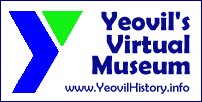Spring Exhibition 2024
Spring Exhibition 2024 - presented by Yeovil's Virtual Museum
Greetings from Yeovil
A History of
Postcards of, or sent
from, Yeovil
(All examples are from my collection)
-
Introduction - and a little bit of postal history
Introduction - and a little bit of postal history
Sadly, postcards
of Yeovil seem
to be
disappearing,
which is a great
pity as they
make a fine
record of the
town's
development
during the
twentieth-century
as this
exhibition will
show.
Further,
visitors to
Yeovil have sent
thousands of
postcards of the
town to friends
and relatives,
often extolling
the virtues of
the town. I have
over a thousand
different
postcards of
Yeovil in my
collection, but
it appears (as
far as I am
aware) that
visitors to the
town today are
unable to send
postcards of
Yeovil
as they are no
longer sold in
Yeovil's shops.
Royal Mail was founded on 31 July 1635 by King Charles I, who made Royal Mail available to the UK public. Post was originally paid by the recipient, not the sender of mail. In 1661 the General Post Office was established and the postmark was introduced. On 6 May 1840, the first ever stamp was created and called the Penny Black.
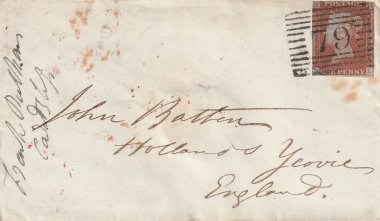
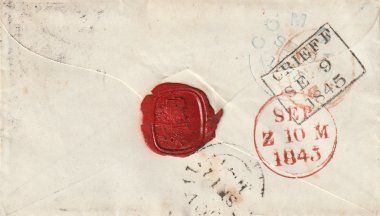
Before 1845, envelopes were handmade, and were available for use by commercial and domestic use. The envelope seen here (front and back) is a very rare manufactured example actually dating to 1845 and was sealed with wax. It measures 4¾" x 2¾" (102mm x 70mm).
It was sent to John Batten of Hollands and bears a Penny Red stamp. The Penny Red stamp was introduced on 10 February 1841. It should, perhaps, be noted that more than 21 billion Penny Reds were produced and used, consequently they are not particularly rare.
![]()
The world’s oldest postal card was sent from London in 1840. The Post Office issued postal cards without images in Great Britain from 1870. Known as 'Postal Stationery', these were printed with a stamp as part of the design, which was included in the price of purchase.
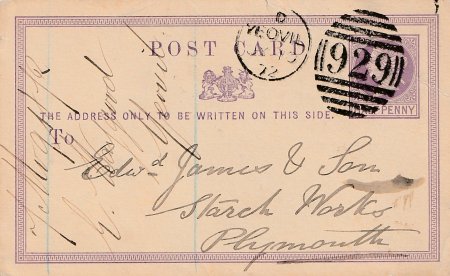
This printed postcard, or 'Postal Stationery', was posted from Yeovil on 10 July 1872, within two years of the printed postcard's introduction. It measures 4¾" x 3" (122mm x 76mm).
It should be noted, that at this time the postal service was well established and offered a speedy delivery service. For example, a postcard sent in the morning from Yeovil to, say, Sherborne, would arrive in the afternoon of the same day. Indeed, the postcard above sent from Yeovil on 10 July, arrived in Plymouth (90 miles away from Yeovil) the next day.
The use of 'Picture Postcards' was first sanctioned by the British Postal Authorities on 1st September 1894, although very few survive from that date. Originally, messages were not allowed to be written on the address side of the card. However, many people were unaware when this rule ceased in 1897. As a result, cards are occasionally found from the first decade of the twentieth century where a message has been written in minuscule writing on the photo side - as this example below. Later, postcard publishers included a space below the image for a message, as seen in the first postcard of the Churches section below.
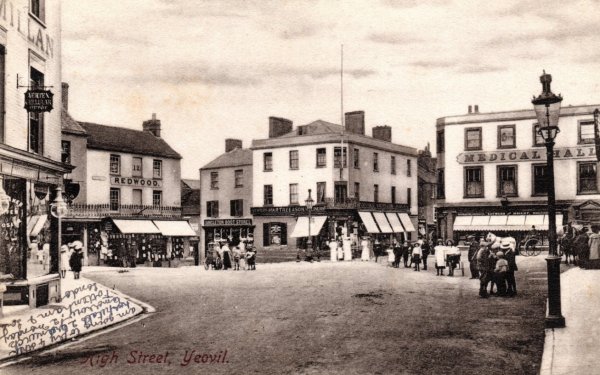
Posted from Yeovil on 30 November 1906, this example featuring the Borough measures 5½" x 3½" (138 x 88mm) which very quickly became the standard size of postcards.
Around 1900 the carte-de-visite and the cabinet card, the most popular photographic formats of the late nineteenth century, were going out of fashion. The new postcard format filled a gap in the growing market and became the new cheap photograph format that could be posted to your family and friends. At the turn of the century, Yeovil was fortunate in having several postcard publishers; bookseller Ebenezer Whitby and printer William Beale Collins, both of Princes Street, two fancy goods dealers - Ince Gamis of High Street and EJ Bowditch of Middle Street, newsagent Henry Balls of the Triangle and Sherborne Road and stationer Mr Hallett "of Yeovil".
Postcards proved immediately popular when they emerged during the 19th-century. The period between the turn of the century and the start of the Great War became known as the "Golden Age" of the postcard and during this time it has been estimated that a staggering 200 billion postcards were in global circulation.
There were two main types of postcard; ‘printed cards’ and ‘photographic cards’. Printed cards were manufactured on a very large scale using printing presses and engraving plates. They are recogniseable when looked at with a magnifying lens, since they are made up of many tiny dots of ink that, when looked at with the naked eye, blend to become almost (but not quite) like a photograph. Real Photographic cards (noted here as 'RP') were actual photographs produced from negatives directly onto postcard-sized photographic paper. The images were often taken by local photographers who sold the cards themselves in limited runs. These type of cards generally show topographical views – a particular street in a village or town, a shop front with the owner outside, a railway station etc.
Since cameras were expensive and not widely available in the early twentieth-century, individuals and families would often visit a local photographer's studio to have their photograph taken. The resulting photographs were turned into postcards so they could be sent to family and friends. This was especially true during the Great War as families, were split up by men going off to war.
It should be remembered while looking at the postcards in this exhibition, that before the 1960s coloured postcards were invariably monochrome images coloured by hand – with varying degrees of success and accuracy.
![]()
Yeovil Churches
Without a doubt, Yeovil's Parish Church of St John the Baptist is the most photographed building in Yeovil. My collection includes 103 different postcards of St John's as opposed to a total of 38 postcards for all the other churches in Yeovil.
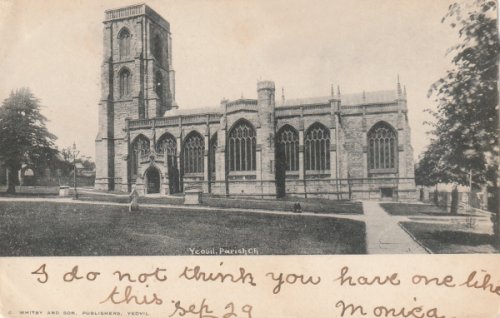
This is one of the earliest postcards of St John's church I have. It was published by E Whitby & Son of Princes Street in 1902 - just four years after the introduction of photo postcards. Most postcards of this time did not have a 'split' back allowing for a message on the left and the address on the right. The difference between this postcard and that of the Borough, above, is that a small strip for a message has been provided below the image - so even the postcard publisher was not aware of the change of rules.
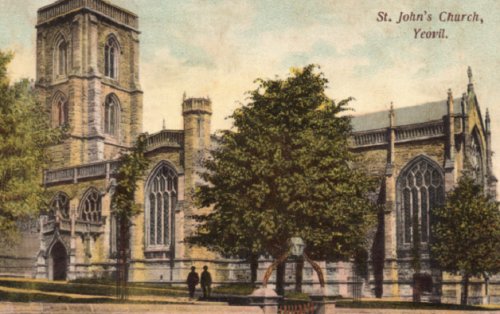
This is the earliest coloured postcard in my collection, albeit subtly coloured. It was produced by WH Hallett, stationer and printer of Yeovil, in 1904.
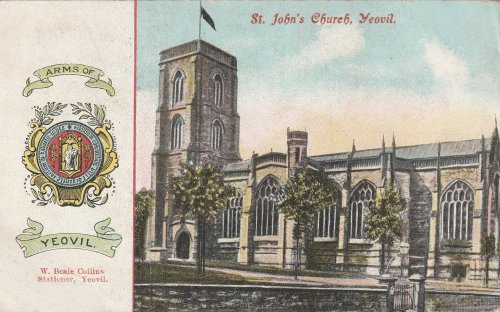
Presumably in an attempt to encourage visitors to Yeovil, William Beale Collins, stationer, printer and publisher of Princes Street, has included "Arms of Yeovil" alongside the image of St John's church in this 1905 postcard.
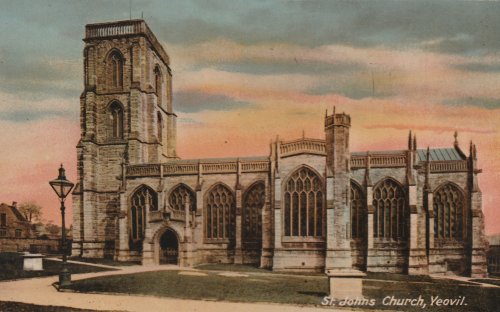
It was not long before large companies began to get in on the act. This postcard is from the Milton "Fac-Simile Sunset" Series, produced by Woolstone Brothers of London from around 1905 to 1915. The postcard is postmarked 1917 but the original photograph was taken several years earlier. The fact that a sunset in the northern sky is somewhat rare, didn't seem to inconvenience them.
While the larger postcard manufacturers, such as Frith of Reigate, Surrey, sent their photographers around the country to get images for their postcards, they also used local photographers. For example, I have several Yeovil postcards, photographed and printed by Whitby of Princes Street, that were later used by Frith under their own brand. (Frith are very keen to enforce their copyright, even today, so you won't see any in Yeovil's Virtual Museum - just the originals - photographed and published by Whitby).
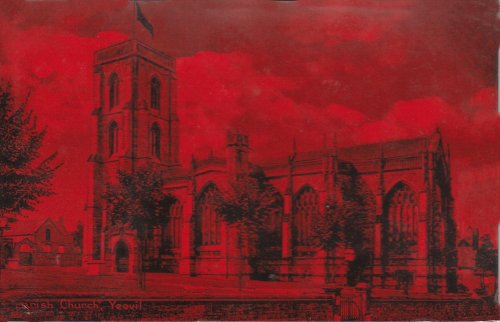
Of course, not every new idea is necessarily a good idea. This is one of several Yeovil postcards in this somewhat overpowering red, produced around 1915 by R Wilkinson of Trowbridge. You may recognise the photograph used - see William Beale Collins' 1905 postcard with the "Arms of Yeovil" above.
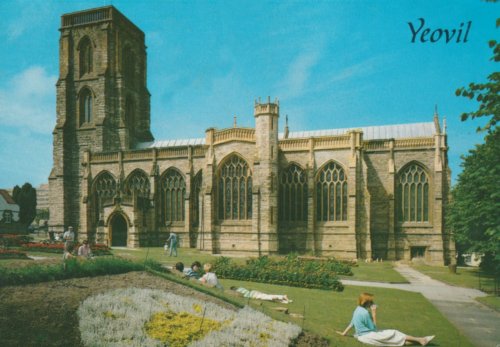
This is an 'RP' postcard of the 1970s. The word ‘real’ was originally used to show that the postcard started its life as an actual photographic negative that had not been printed by machine and turned into a mass-produced image. It was the ‘real’ thing and not a reproduction.
![]()
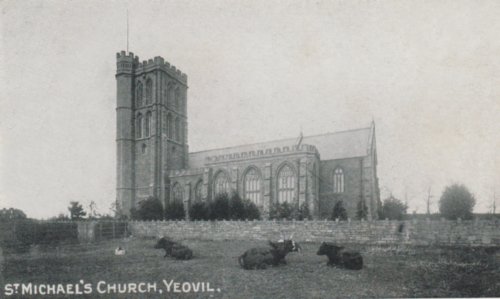
St Michael & All Angels’ church was designed by Yeovil architect J. Nicholson Johnston in a uniform early fifteenth century style with touches of Art Nouveau. Largely paid for by the Cole family, it cost in the region of £10,000 (about £2 million at today's value) and opened in 1897 to serve the newly-formed Pen Mill parish.
The postcard above dates to 1905 and was originally issued (and probably photographed by) William Hallett. It was produced in different issues used into the mid-1920s - I have eight different postcards using the same image, including the coloured version set within a vignette from Milton's "Sell-Well" range, below, posted in 1913.
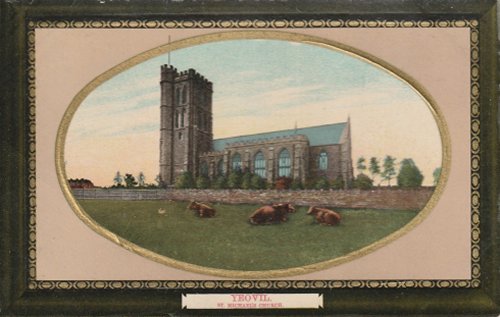
![]()
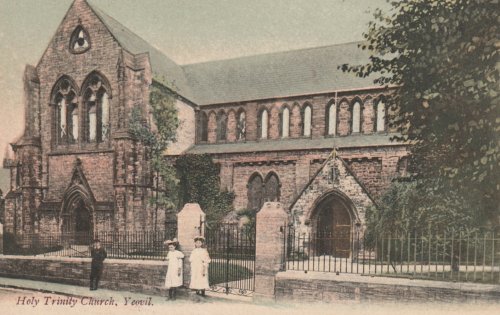
This
image
features in my
book 'Yeovil
- The Postcard
Collection'.
Designed by the famous diocesan architect Benjamin Ferrey, the foundation stone of Holy Trinity in Peter Street, was laid on the 24th June 1843 and the church was consecrated on the 28th of October 1846. This printed postcard by the printer and bookseller William Beale Collins of Princes Street, dates to about 1905.
![]()
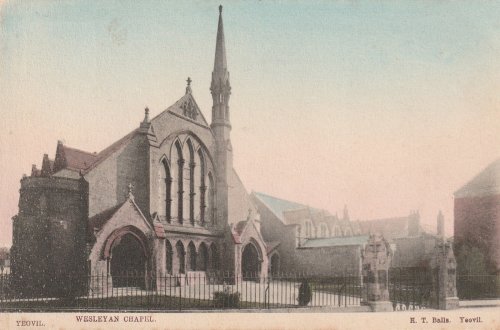
This
image
features in my
book 'Yeovil
- The Postcard
Collection'.
In 1869-1870, the new Wesleyan Methodist church was built in Vicarage Street and opened on 30 March 1870. On Monday 7 October 1940 the first Luftwaffe raid on Yeovil occurred in the afternoon when a flight of twenty Junkers JU88 twin-engine medium bombers dropped over thirty high explosive bombs and eighteen oil bombs on Yeovil. A direct hit on the Methodist church's public shelter killed four people. The church itself also suffered substantial damage to its fabric, including the loss of the tall pinnacle seen here.
This subtly-coloured printed postcard of the church is by newsagent Henry Balls of Sherborne Road and dates to around 1908.
![]()
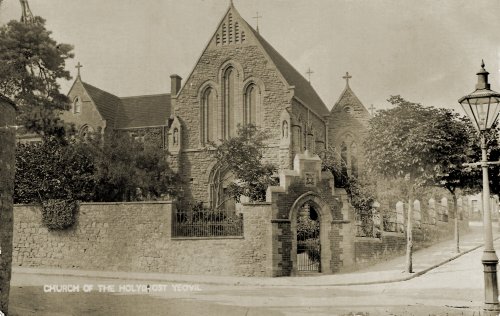
In 1896,
the
Reverend AJC
Scoles, an
architect and
the parish
priest, built a
new Roman
Catholic church
and presbytery,
in the Early
English style
between 1894 and
1899.
A sepia 'RP' postcard of the Church of the Holy Ghost in Higher Kingston, by an unknown photographer and unknown publisher. The date is also unknown, although it is known to pre-date 1918, since the reverse carried a small printed square where the stamp usually goes and is printed "Inland Halfpenny Stamp, Foreign One Penny" - the postage price for postcards increased to one penny on 3 June 1918.
![]()
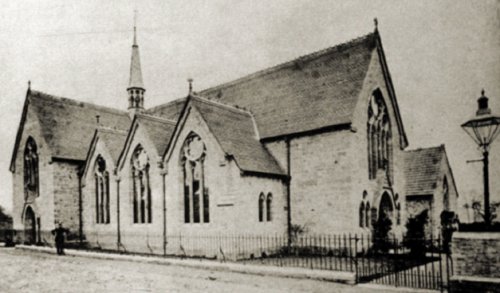
This
image
features in my
book 'Yeovil
- The Postcard
Collection'.
The Reformed
Episcopalian
Christ Church
was built
in
Park Road in the Early
English Revival
style. It opened
in 1880 but the
congregation
dwindled
dramatically and
in 1904 it was
demolished –
lasting just
twenty-five
years. The
photograph was
taken in 1880,
but the postcard
was used in
1903.
![]()
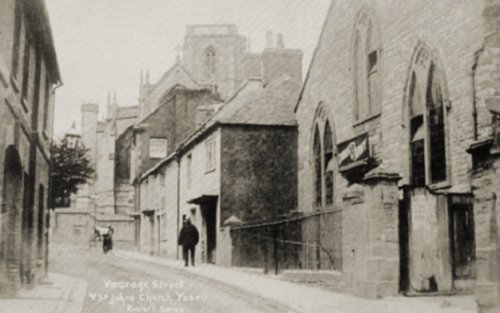
This
image
features in my
book 'Yeovil
- The Postcard
Collection'.
The
Unitarian
chapel in
Vicarage Street
was built on the
site of the
medieval
Chantry
of the Blessed
Virgin Mary. The
chapel was
founded in 1704
but rebuilt in
1809 and this is
the building
seen in
this
postcard, of
around 1910. The
chapel was
demolished in
the early 1980s
for the
construction of
the Quedam
shopping
precinct.
![]()
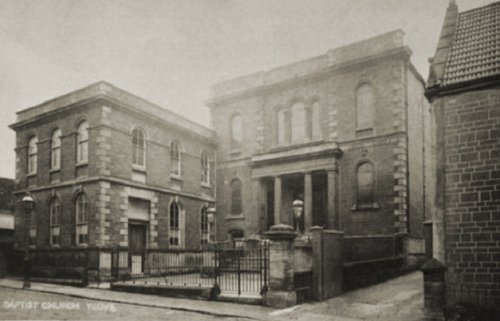
The
Baptist
church in
South
Street, seen
here,
was built on the
site of a barn
first used for
meetings from
1668. A chapel
was built in
1810 and
replaced in
1828. It was
enlarged in 1868
and a choir
added in 1898.
This postcard
dates to 1912.
![]()
High Street and The Borough
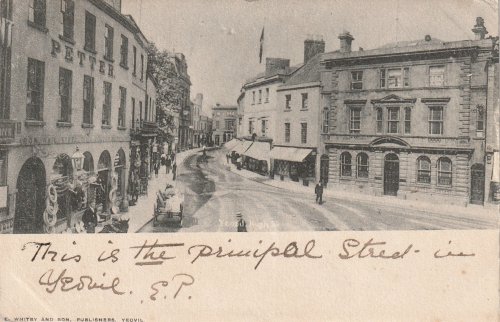
A Whitby & Son postcard of High Street and the Borough (technically still part of High Street) dating to 1903. The photograph is clearly taken from the first floor of the Medical Hall. Again, a strip for the message on this printed postcard is included below the image even though not necessary by this time.
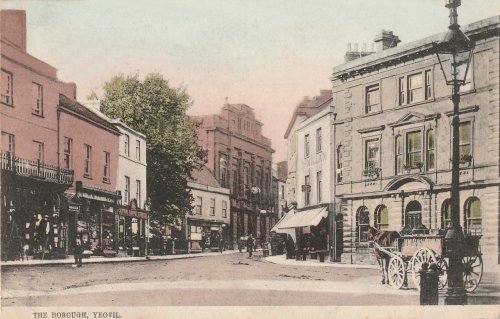
This subtly hand-coloured image was, I suspect, taken by or for Hallett the stationer of Yeovil who published postcards in the 1900s. This image, with a horse and cart by the lamp post, first appeared on a Hallett postcard of 1905 with a message strip (as in the postcard above) and was still being used at the start of the Great War in 1914. From 1907 postcards with this image were being produced by the firm of Milton. I have seven variations of this postcard, both printed and 'RP' and produced in monochrome, sepia, colour washed (as this example) and fully hand-coloured.
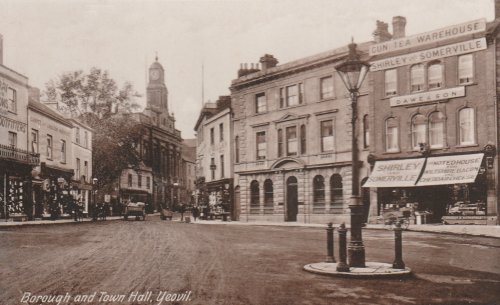
This 'RP' postcard, by HT Balls was published in 1915 and features the new clock tower on the Town Hall that had been erected in 1912. (The tree is where King George Street is today). Note that a horse and cart is shown in the distance and the road is marked with cart tracks.
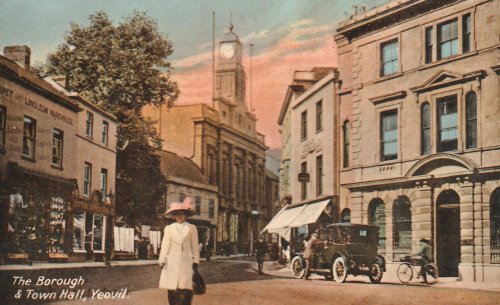
This photograph
features in my
book 'Yeovil
From Old
Photographs'
Almost the same view, but this 1914 'Fac-Simile Sunset' postcard features an automobile - proving that Yeovil was keeping up with the times. It's nice to see that this sunset is in the west. Again, there are at least five versions of this postcard, and the image was being used into the mid-1920s - including a version with the overpowering red as seen above. This was the last postcard of the Borough not to feature the now-familiar War Memorial.
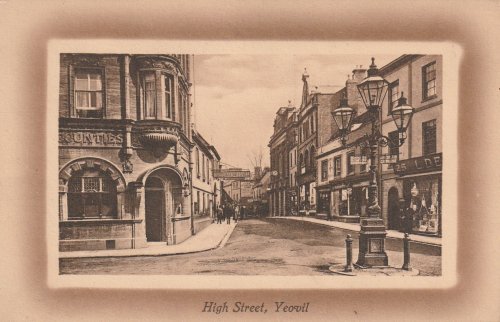
The photograph use for this printed postcard, of High Street looking east, was taken in 1899. The image was used in 1904 by Collins, Whitby and Hallett, all small publishers of Yeovil, and from 1906 until at least 1912, by Valentine & Sons of Dundee and London in at least nine variations. The rectangular vignette version, seen here, was published by William Beale Collins.
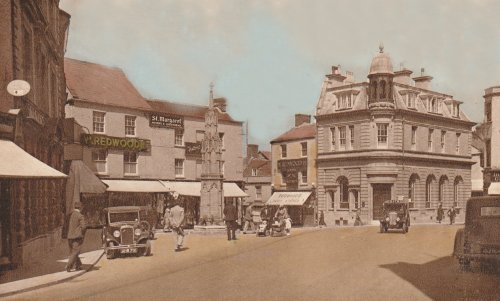
A hand-coloured printed postcard of the Borough, by an unknown photographer / publisher, but posted in 1959.
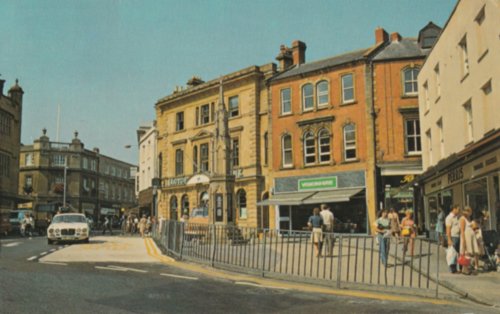
The final postcard in this section is by Photo Precision Ltd., of St Ives, Cornwall, and was posted in 1983.
![]()
Middle Street and The Triangle
The postcards in this section of Middle Street and The Triangle begin at the western end, by the Borough, and proceed east as far as Wyndham Street.
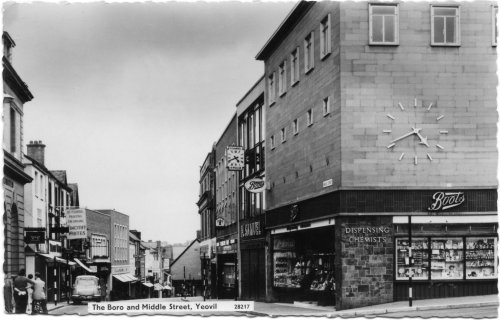
An 'RP' postcard by an unknown publisher dated 1963, showing Middle Street seen from the Borough and featuring the (relatively) new Boots' building. Remember the clock?
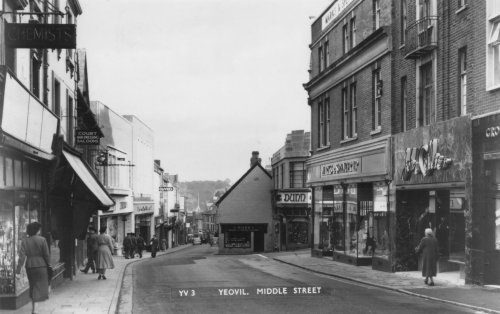
This image
features in my
book 'Yeovil
- The Postcard
Collection'.
This postcard, from Mason's 'Alpha' series, dates to 1955. Looking east along Middle Street, Union Street runs off right in front of Dunn's gents outfitters building (which probably dates to the early 1940s). Note that, at this time, the old post office building (now WH Smith's premises) were occupied by Marks & Spencer.
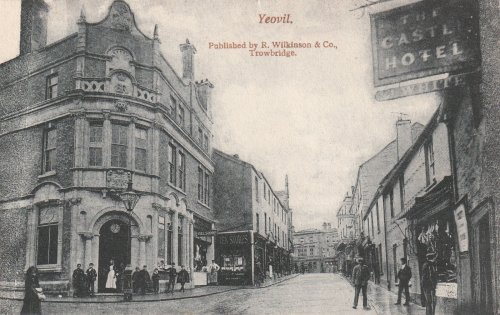
This printed postcard of the Post Office in Middle Street (now the premises of WH Smith) was published by R Wilkinson & Co of Trowbridge in 1903 - the year the building opened.
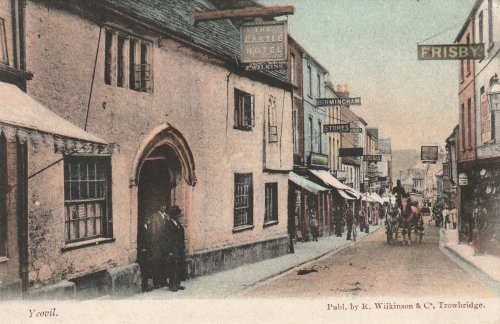
A printed hand-coloured postcard of 1904 by R Wilkinson & Co of Trowbridge, Wiltshire, featuring the Castle Inn in Middle Street (opposite Union Street), looking east. Wilkinson produced at least three versions of this postcard - this, the same in monochrome and a monochrome version with a message panel to the right of the image.
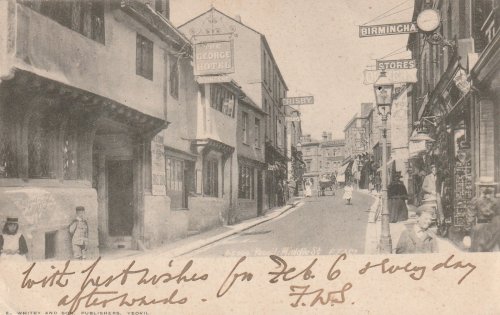
A 1903 printed postcard by Whitby, looking west and featuring the George Inn. At this time, the George's half-timbered structure was plastered over. The George Inn began life as a private dwelling, built during the 1400’s and from 1478 it was owned (among other licensed premises) by the Trustees of Woborn's Almshouse.
The George was almost certainly the most photographed secular building in Yeovil. I have fifty-five postcards in which it features.
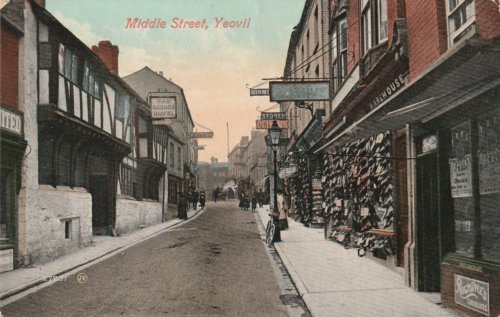
Almost exactly the same view in a hand-coloured printed postcard of 1909, by Valentine & Sons Ltd, Dundee & London. In the six years separating these two images of the George Inn, either the plaster to the upper storey had been removed, exposing the structural timbers, or a false 'Tudor' facade had been applied. From photographs taken during the 1962 demolition of the George, it appears to have been the latter.
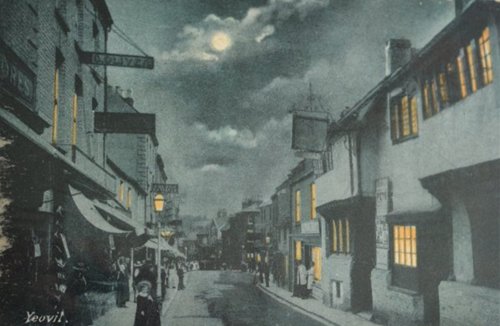
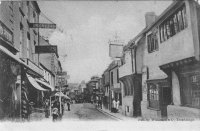 Probably
one of the most
unusual
postcards in my
collection, the
night scene
above was
'converted' from
an ordinary
daytime
monochrome
postcard image,
seen at left.
The original
postcard was
published by
Wilkinson & Co.
of Trowbridge in
1904. It was,
presumably,
Wilkinson's art
department that
created the
night scene.
Probably
one of the most
unusual
postcards in my
collection, the
night scene
above was
'converted' from
an ordinary
daytime
monochrome
postcard image,
seen at left.
The original
postcard was
published by
Wilkinson & Co.
of Trowbridge in
1904. It was,
presumably,
Wilkinson's art
department that
created the
night scene.
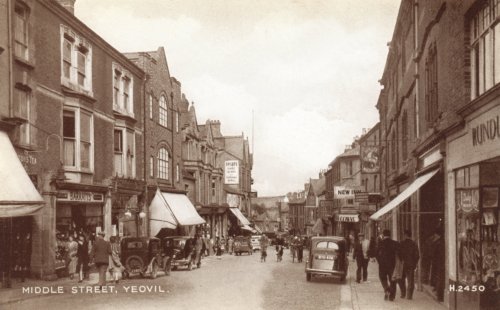
From their "Photo Brown" series, this printed postcard by Valentine & sons of Dundee and London, dates to 1943. It looks east along Middle Street close to its junction with the Triangle. Cards of this period, as this one, frequently featured encouraging wartime messages from Prime Minister Winston Churchill on the address side - in this instance "We shall continue steadfast in faith and duty till our task is done".
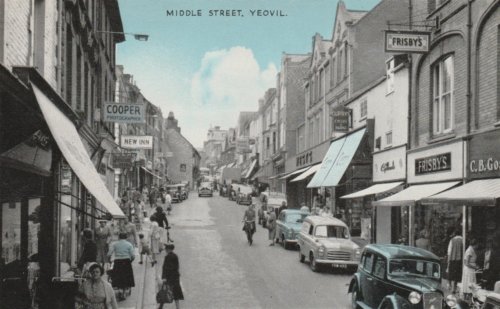
A 1950's postcard of Middle Street, looking back to the George projecting out. At this point, Middle Street had only been 12' 4" (3.75m) wide for centuries. The postcard is from the 'PhotoBlue' series by ETW Dennis & Sons Ltd of London. The 'PhotoBlue' series was, apparently, quite popular at the time.
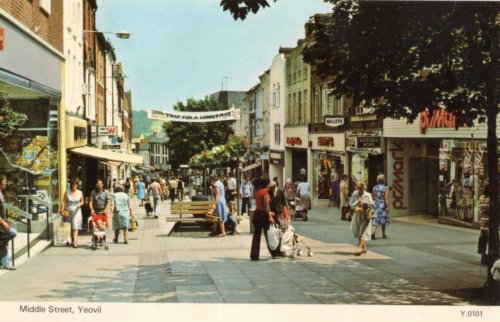
This printed postcard was meant to display the newly-pedestrianised Middle Street and promote Yeovil as a modern shopping centre. The postcard, from the 'Photocolour' series of ETW Dennis & Sons (by this time, of Scarborough), dates to 1979 - this was the year ‘Trap for a Lonely Man’ was performed at the Swan Theatre, advertised on the banner across the street. Some of these shops will be familiar, all the buildings remain, it's just the shop occupiers that have changed.
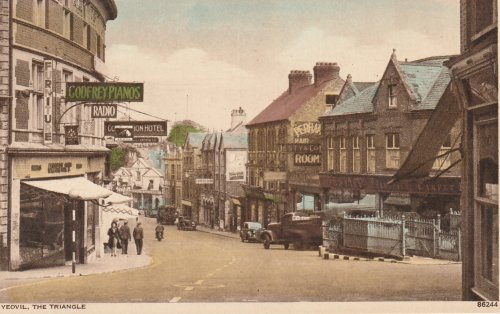
This printed hand-coloured postcard, by Photochrom of Royal Tunbridge Wells, dates to the 1940s (with another encouraging wartime message from Winston Churchill on the address side). The view looks down Lower Middle Street with the infamously malodorous underground toilets at the right and the Coronation Hotel and Vaults, housing Godfrey’s piano shop in one corner, just glimpsed at left.
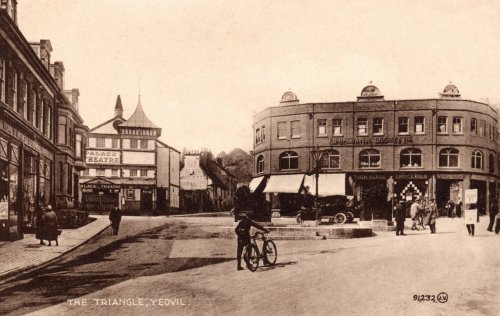
The area known today as the Triangle is where Middle Street, South Street, Vicarage Street, Stars Lane and Fore Street (Lower Middle Street) met and in earlier times was the easternmost point of the Borough of Yeovil. This printed postcard, from Valentine's "Sepiatype" series, was sent in 1927. It shows the infamous underground toilets in front of the Co-operative Society building with the Palace Theatre, on the corner of Stars Lane and South Street, at left.
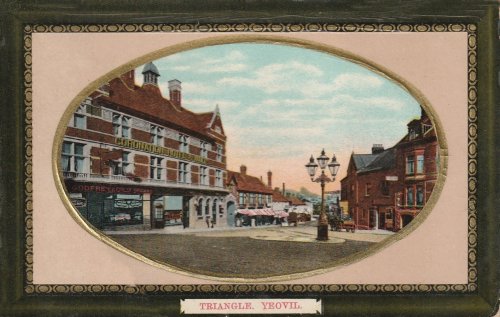
From the Milton "Sellwell" series, by Woolstone Brothers of London, this vignette postcard was sent in 1913. The impressive Coronation Hotel and Vaults, at left, was built around 1900 but was demolished in the 1960s, together with all the buildings beyond it, for the building of the new Glovers Walk shopping precinct.
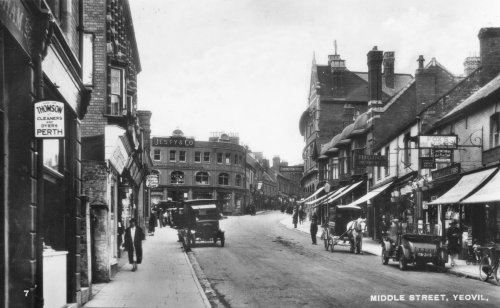
This 'RP' postcard is by an unknown publisher and dates to1923 - an age when the horse-drawn vehicle competed with the motor vehicle. It is taken from Lower Middle Street, looking back towards the Triangle.
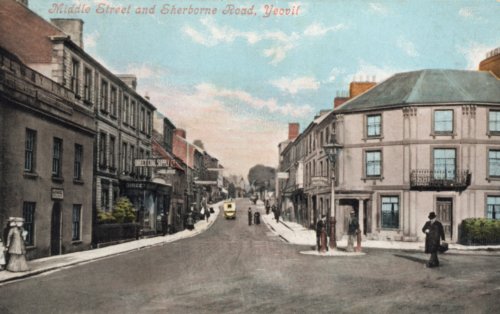
This printed postcard by Valentine shows the eastern end of Lower Middle Street and, at right, the entrance to Station Road. This postcard appeared in several forms; monochrome and at least three different hand-coloured versions such as this example. This example was used in 1907 and features the Railway Inn (demolished in 1913 and now the site of Central Road) at the extreme left and the Fernleigh Temperance Hotel (later a restaurant) at right.
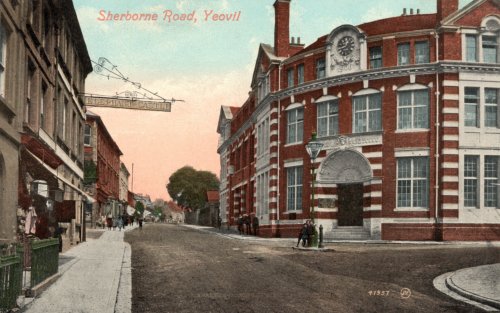
Another hand-coloured printed postcard by Valentine, this of 1906, features the newly-opened Western Gazette offices that were officially opened the same year. The construction company was Bird & Pippard, builders and undertakers of Middle Street. The new building was constructed using 600,000 bricks on a steel-girder framework.
![]()
Hendford Hill to Fiveways
This section does what it says - postcards from Hendford Hill to Fiveways, via Hendford, Princes Street and Kingston.
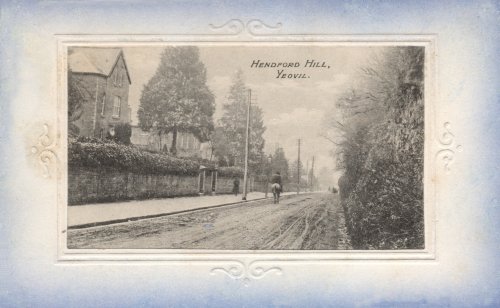
Published by FJ Bowditch of Middle Street in 1911, this view from the 'top' of Hendford Hiil is set within a vignette on a decorative and coloured mount. This is a style that was highly fashionable this time.
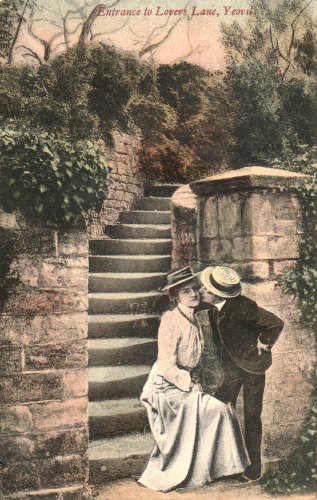
This, apparently, was the entrance to Lovers' Lane, halfway up Hendford Hill. It was published by RJ Wilkinson & Co of Trowbridge. The card was posted in 1906.
In the past Lovers' Lane, originally cutting off the corner between Hendford Hill and the Dorchester Road, has also been known as Crewkerne Hollow, the Old Holloway and simply Old Hollow. In fact it seems certain that the lower level of Lovers' Lane, together with Rustywell on the other side of Hendford Hill, followed the line of the old Ilchester to Dorchester Roman road as it ascended the hill.
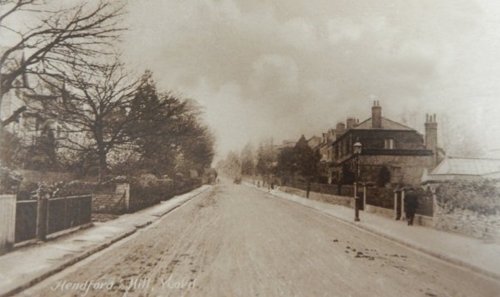
This printed postcard, by an unknown publisher, dates to 1905 and looks up Hendford Hill from a position close to Rustywell. The houses to the right were built during the mid-Victorian period. At the left of the image, today's houses are yet to be constructed on land that had, during Victorian times, been a tree nursery.
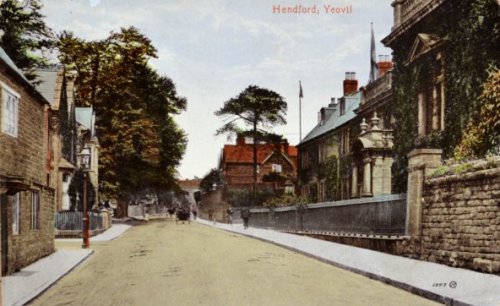
This
photograph
features in my
book 'Yeovil From Old Photographs'.
Moving along Hendford, this delightful hand-coloured printed postcard of about 1914 looks north towards the town centre, with Hendford Manor at right.
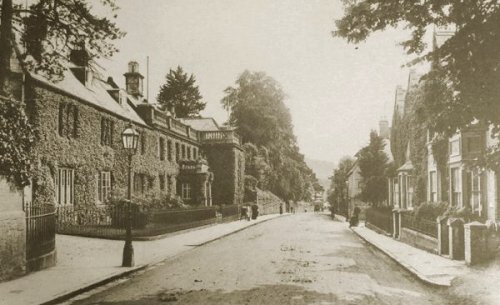
This
image
features in my
book 'Yeovil
- The Postcard
Collection'.
... and looking south along Hendford, with Hendford Manor on the left, in a postcard sent in 1912. Hendford Manor was originally built about 1740 for James Hooper, a Yeovil solicitor.
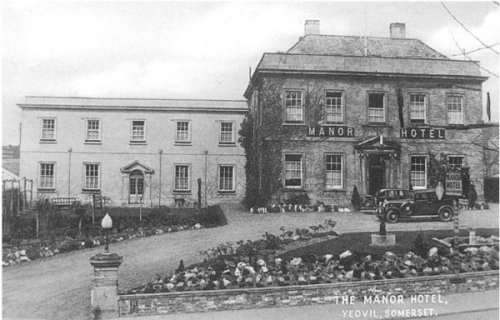
The Manor Hotel as seen in a printed advertising postcard from the 1930s. The Manor Hotel, on the western side of Hendford, with its fine Georgian five-bay Ham stone elevation and recessed five-bay stable block, was built in 1776 and was originally the private house, known as Hendford House, of local glover John Daniell the elder.
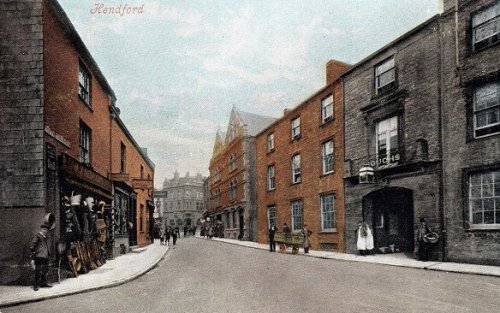
This
image
features in my
book 'Yeovil
- The Postcard
Collection'.
A hand-coloured printed postcard of the northern end of Hendford, dating to about 1905. At right is the Three Choughs Hotel and at left is the ironmonger's shop of Henry James Sercombe who was listed as a 'tinman' in trade directories between 1903 and 1923.
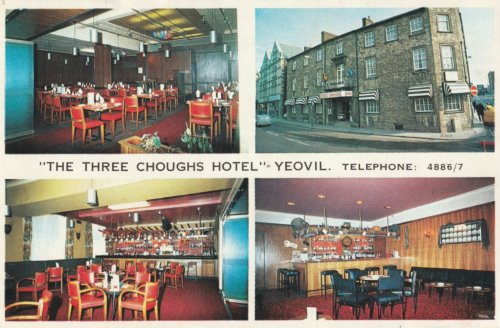
A printed advertising postcard of, and issued by, the Three Choughs Hotel. This postcard dates to the 1970s.
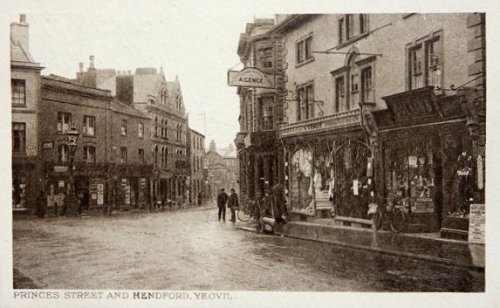
This
image
features in my
book 'Yeovil
- The Postcard
Collection'.
This postcard of the northern end of Hendford, postally unused, I'd guess dates to about 1900. At extreme left is just seen the edge of Lindsay Denner's shop and next to it are the remaining shops before he took them over. The two men at centre are standing outside Stuckey's Bank (demolished before 1918) and between the bank building and Genge's shop is the narrow entrance to Porter's Lane (later widened to become today's Westminster Street).
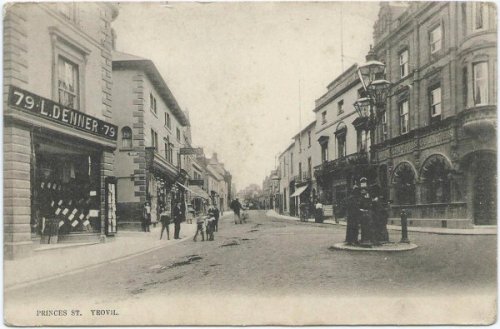
This photograph
features in my
book 'Yeovil From Old Photographs'.
This printed postcard of Princes Street was used in 1905, although I have seen it as early as 1903. At left is Lindsay Denner's "gentleman's and juvenile ready-made and outfitting establishment" at 79 Hendford, immediately next to the narrow entrance to Porter's Lane. Denner's shop would be demolished around 1919 for the widening of Porter's Lane into today's Westminster Street. On the opposite corner is 1&3 Princes Street - the building that had been William Porter's printing works and bookshop is still there today and bears a blue plaque celebrating Porter's shop. At right is the Capital & Counties Bank building which opened in 1897.
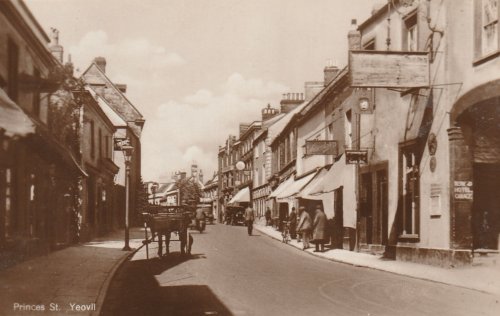
Princes Street in a postcard of 1935. At extreme right is the garage entrance to the Mermaid, but the shops next door are now re-fronted on the ground floor and currently occupied by Chant's estate agent.
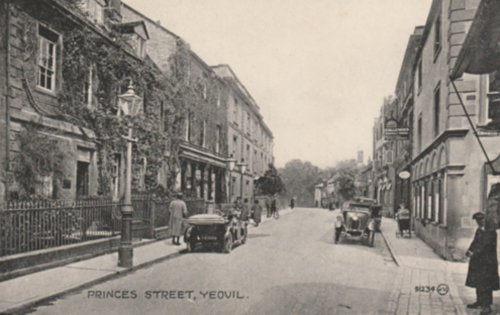
The
original
image
features in my
book 'Yeovil
- The Postcard
Collection'.
The photograph for this printed postcard of 1924, from Valentine's "Bromotype" series, was taken further along Princes Street - the entrance to Church Street is glimpsed at right. Note that Vincent's showroom has yet to be built in the distance.
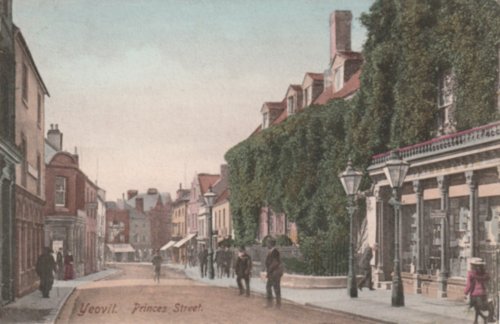
The original
photograph
features in my
book 'Yeovil From Old Photographs'.
Turning to look back south, this particular hand-coloured printed postcard was sent in 1907, but the image had been used on postcards at least as early as 1903. I have six different versions of this postcard, but this is the only coloured version. It features Ebenezer Whitby & Sons' bookshop, printers and stationers at (now 31) Princes Street - who published this postcard - with a pair of single Sugg lamps outside. These, and a third just down the street, were the only streetlights in Princes Street at the time.
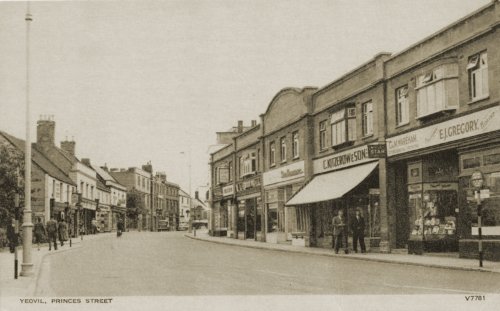
The northern end of Princes Street, featuring Yeovil's New Shopping Centre, seen in a Photochrom Co of Royal Tunbridge Wells printed postcard. This postcard was sent in 1961 (although the serial number 'V7781' dates the photograph to between 1942 and 1952). The three shops at right were Kitzerow & Sons (shoe shop), C&M Wareham (confectionery & cigarettes) and EJ Gregory (fruiterer & florist).
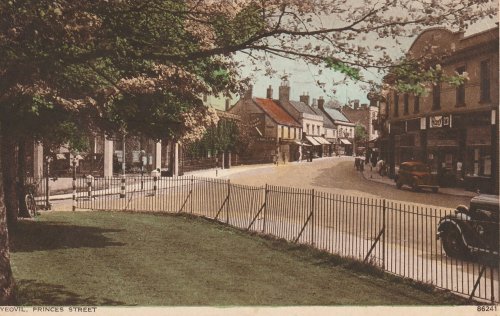
A 1940s Photochrom hand-coloured printed postcard. It was taken from Bide's Gardens and shows the northern end of Princes Street / southern end of Kingston, with Court Ash running off to the left. At this time, before Reckleford was made a dual carriageway and Yeovil lost Bide's Gardens (the photographer of this photograph would today be standing on the southern carriageway of Reckleford as it approaches the hospital roundabout), Princes Street ended at North Lane on the eastern side while the western side of Princes Street ended at Park Road.
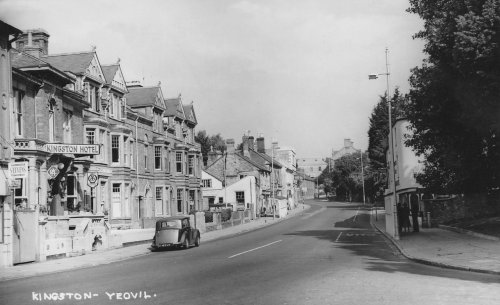
Turn around from the previous postcard, and this is the view you would have seen - the southern end of Kingston. In this photograph of 1956 by HA 'Jack' Cooper, Pitney Villa in its guise as the Kingston Hotel is at left and the short terrace of three-storey villas would later be absorbed into the Kingston Hotel. On the right is the Red Lion Hotel, partially obscured by the tree that stood in the extreme corner of Bide's Gardens.
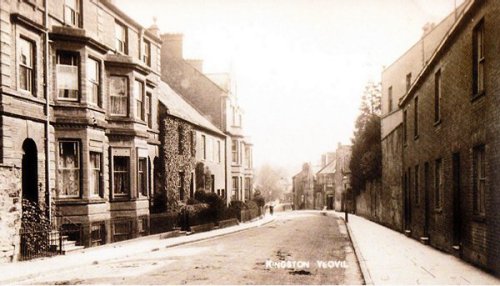
Compared with today's dual carriageway, Kingston of the 1940s was extremely narrow. All the buildings at left were demolished for the widening of Kingston and for today's District Hospital. At right is the terrace known as Kingston Villas and the wall of Kingston House (later occupied by the Park School) - the only survivors from Kingston's early days.
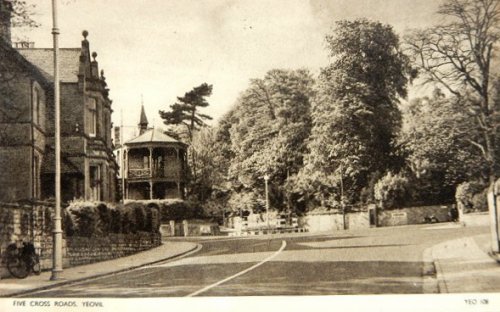
This
image
features in my
book 'Yeovil
- The Postcard
Collection'.
A printed postcard, of the 1950s (this example posted in 1959), from the "Chrome Series" by Jarrold & Sons of Norwich, showing the hospital and the Five Crossroads roundabout as seen from Kingston.
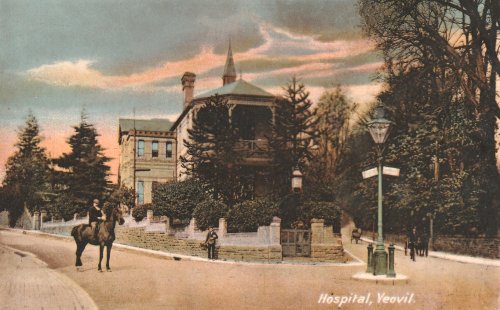
The Fiveways Hospital opened in January 1872, just as an outbreak of smallpox hit Yeovil. This image appears on at least four different postcards between 1910 and this example of 1914, from Milton's "Fac-Simile Sunset" series.
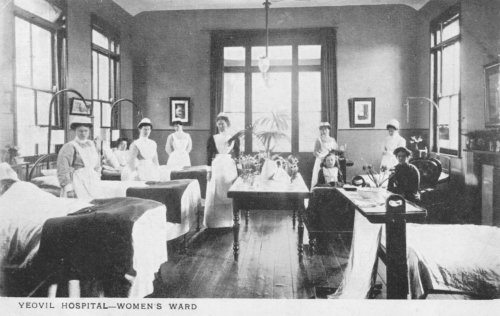
Unusually, this printed postcard of the Fiveways Hospital's women's ward, was sold at the hospital for patients to send to family and friends - and I have a similar card from the men's ward. The photograph dates to 1909 but this example was posted in 1911. There are no details of the published, but for the word 'Sanbride'.
![]()
Other Roads
This section is not so much a structured display, but since so few postcards feature minor roads, it is more of a hotch-potch of various postcards from my collection. So, in no particular order other than roughly alphabetical...
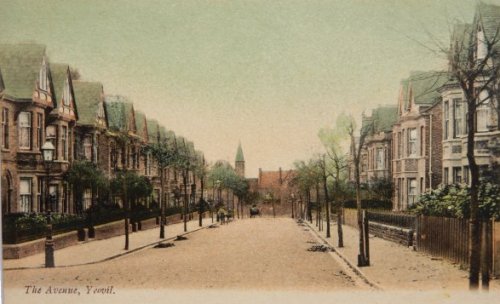
This
postcard
features in my
book 'Yeovil From Old Photographs'.
In 1896 Captain Prowse, Lord of Kingston Manor, sold some seven acres of land north of Higher Kingston to the Reverend (later Canon) AJC Scoles, an architect and the parish priest, The purchase was to provide land to build a new Roman Catholic church, a presbytery and a school as reported in the press at the time ".... The main road through the estate will be an Avenue 40 feet wide and houses will be erected on either side." This somewhat grainy hand-coloured printed postcard, dated 1905, of the newly-built Avenue is by William Beale Collins of Princes Street.
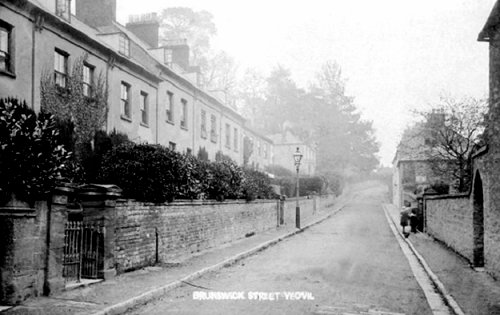
This 1906 postcard shows Brunswick Street, seen from close to the junction with Hendford. All the properties at left - Brunswick Place and Brunswick Terrace - were demolished in the 1960s for road widening.
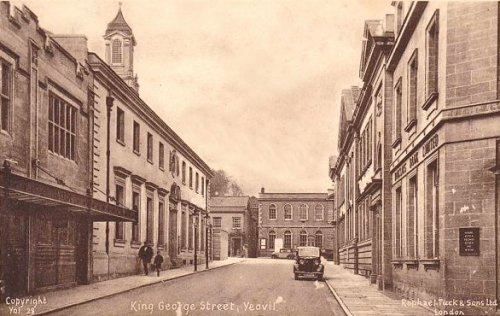
This
postcard
features in my
book 'Yeovil
- The Postcard
Collection'.
A printed postcard of King George Street, taken from High Street and looking towards South Street. It was published by Raphael Tuck & Sons. Although you can't see it in this image, the car's registration is YO6938 - dates this postcard to around 1932 - just after the buildings on the left were opened.
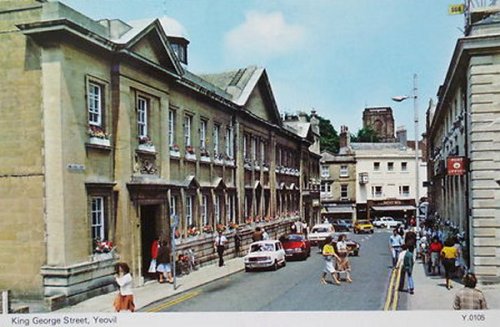
This
postcard
features in my
book 'Yeovil
- The Postcard
Collection'.
A 1980's printed postcard of King George Street, looking north towards High Street. The postcard was published by ETW Dennis & Sons of Scarborough. This is just how I remember King George Street when I worked in the Municipal Offices during the 1970s and 1980s.
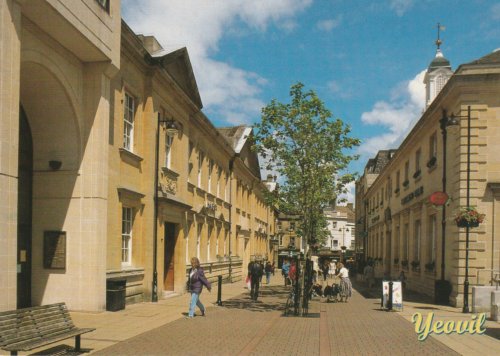
This is probably one of the last postcards to be produced featuring Yeovil. It is undated but, judging by the size of the trees, I'd guess at late 1990s or early 2000s. It is a printed postcard, featuring the newly-pedestrianised King George Street by John Hinde of Redruth, Cornwall.
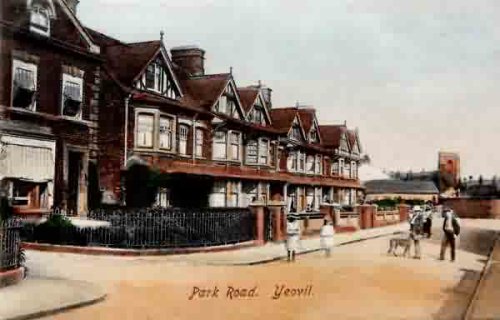
This
image
features in my
book 'Yeovil
- The Postcard
Collection'.
This hand-coloured printed postcard, by Whitby & Son of Princes Street, is from an original photograph taken in 1910. It looks east along Park Road towards Clarence Street, with the Armoury just out of shot at right. All these buildings were demolished for the construction of Queensway in 1976.
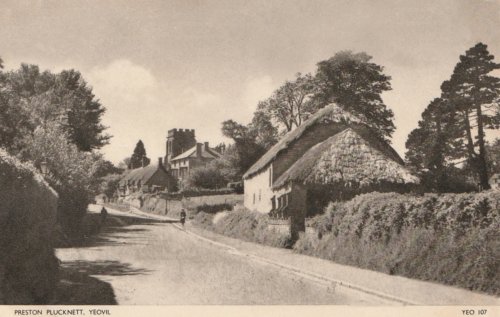
A printed postcard of 1954, featuring Preston Road as it approaches Preston Plucknett. In the distance is seen the tower of St James’ church. The majority of the cottages in Preston Plucknett, on either side of Preston Road, were demolished for road widening and straightening in the 1960s. The postcard was published by Jarrold & Sons of Norwich in their "Crome" series.
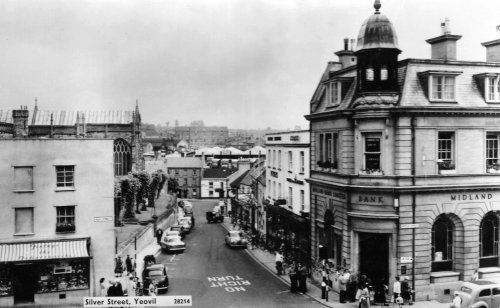
An 'RP' postcard of the 1960s. showing the 'top' of Silver Street from the 'St Albans' series by an unknown publisher.
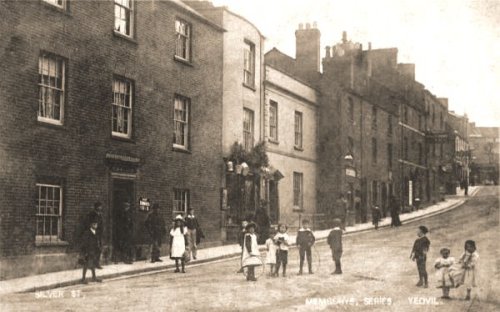
This
postcard
features in my
book 'Yeovil
- The Postcard
Collection'.
This printed postcard, from the 'bottom' of Silver Street, dates to around 1900 and is from the "Membury Series" by an unknown publisher. Henry Little's gun shop cum ironmongery was the three-storey, single-bay bow fronted building adorned with buckets and other ironmongery paraphernalia, next to the Pall Tavern (in naked brickwork!).
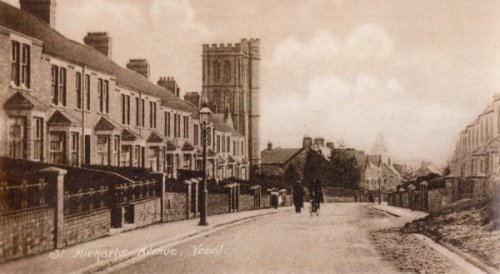
This postcard
features in my
book 'Yeovil From Old Photographs'.
A printed postcard of 1920, looking south down St Michael's Avenue towards the church. Note the unfinished road at bottom right. This was published by G Amis & Co of 6 High Street.
![]()
Open Spaces
Bide’s Gardens were donated to the town by Thomas William Dampier-Bide (1844-1916), the son of glove manufacturer Thomas Dampier (1801-1876). He lived in Kingston Manor House and on his death in 1916 bequeathed to the town a large part of the grounds of Kingston Manor House (lying between Higher Kingston, Court Ash, Court Ash Terrace, Kingston and Red Lion Lane).
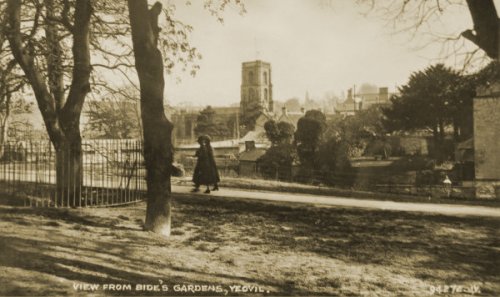
This
postcard
features in my
book 'Yeovil
- The Postcard
Collection'.
An 'RP' postcard dated 1926 from Valentine's 'XL' series, depicting the view from Bide's Gardens looking across to St John's church.
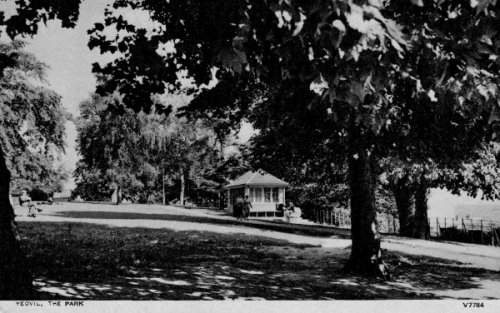
This postcard
features in my
book 'Yeovil
From Old
Photographs'
A postcard of Bide's Gardens in the 1950s, by Photochrom Ltd of Tunbridge Wells.
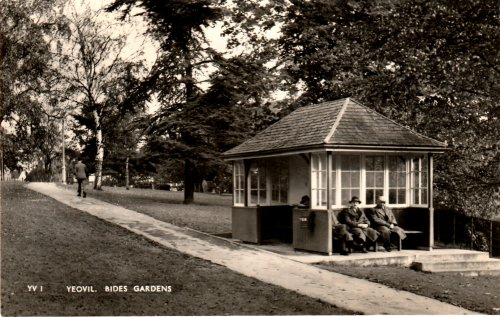
... and a close-up of the shelter in a 1950s' 'RP' postcard from Mason's 'Alpha' series.
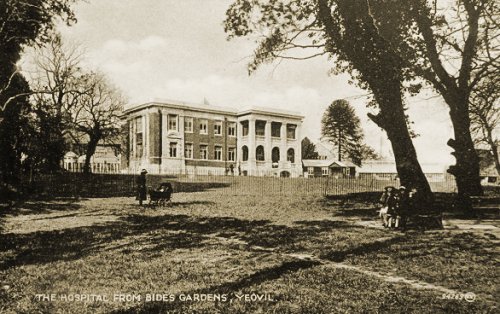
This
image
features in my
book 'Yeovil
- The Postcard
Collection'.
An 'RP' postcard from the 1920s (published by Valentine and postmarked June 1930), showing the new hospital as seen from Bide's Gardens.
![]()
Sidney Gardens, a three acre triangle of open space in Ram Park, was presented to the town by Alderman Sidney Watts when he was mayor to commemorate the 1897 diamond jubilee of Queen Victoria, although the gardens were not officially opened until 23 June the following year.
Always a very popular place to photograph, I have 68 different postcards of Sidney Gardens.
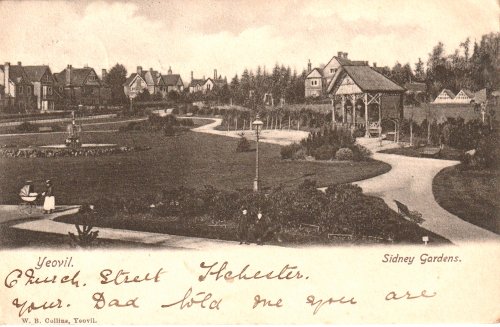
A 1903 printed postcard of Sidney Gardens, published by William Beale Collins of Princes Street.
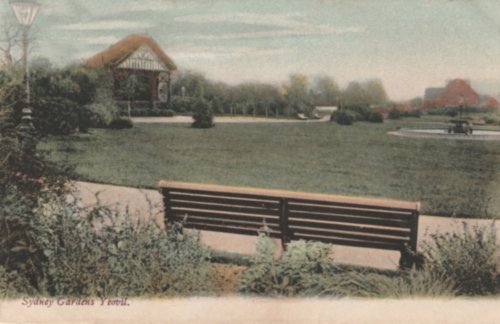
A hand-coloured printed postcard of 1905, featuring both the bandstand and the fountain. The postcard was published by R Wilkinson of Trowbridge.
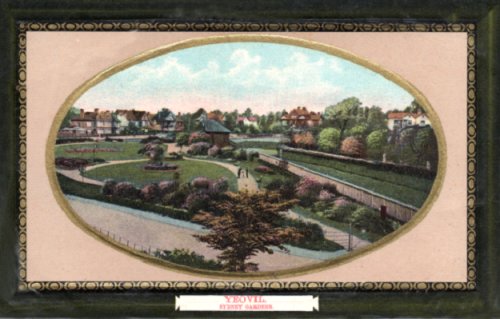
I have this postcard in nine different versions; the earliest is from the Wrench Series (only produced in 1903/04). Postcards using this image were published by J Membury of Yeovil (possibly the original publisher) and several versions in the various 'Milton' series by the Woolstone Brothers of London - including this "Sellwell" series version of around 1909.
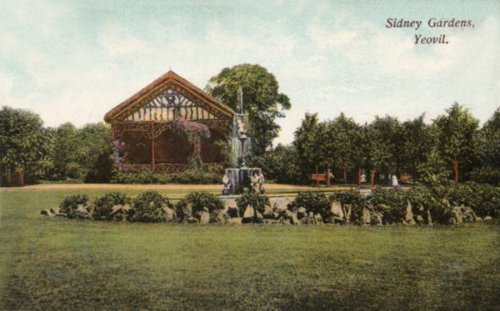
This postcard
features in my
book "A-Z
of Yeovil"
A printed postcard by WH Hallett of Yeovil, posted in 1907, featuring both the bandstand and the fountain.
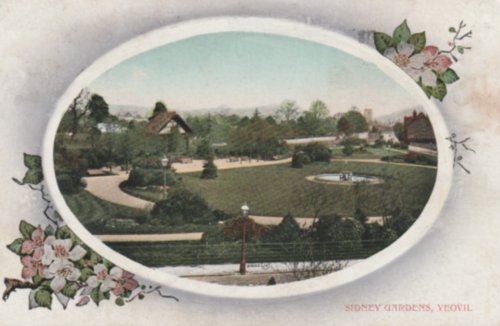
A delightful postcard featuring a floral vignette. This postcard is dated 1918 but the publisher's name is absent. I have eight different postcards using this image; the earliest are by HT Balls and William Beale Collins, both of Yeovil, but all the others are in various series published by Valentine - so perhaps this vignette card is too?
![]()
Now part of Yeovil Country Park, Ninesprings is, essentially, a broad-leaved woodland valley of some twenty acres on the south east edge of Yeovil with nine springs supplying water to small streams and ponds. The water issues into Dodham Brook and, ultimately, to the River Yeo. It was developed as an ornamental park for the Aldon estate during the early nineteenth century and included walks, bridges, grottoes, springs and lakes. Until the middle of the twentieth century the public only had access by ticket obtainable from the owner, Colonel HB Batten, the Town Clerk.
Probably photographed more than any other location in Yeovil, especially for postcards and more especially the cottage - I have an astonishing 120 different postcards of Ninesprings, of which 81 feature the cottage.
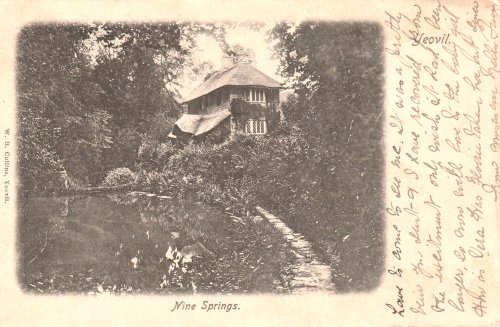
My earliest postcard of Ninesprings and the Cottage. This was published by William Beale Collins of Princes Street and posted in 1902.
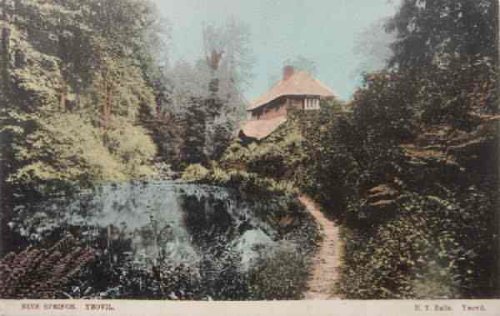
Without doubt one of Harry Thomas Balls' first postcards - this hand-coloured printed postcard of Ninesprings Cottage was posted in 1903, just after he had set himself up in business in Yeovil.
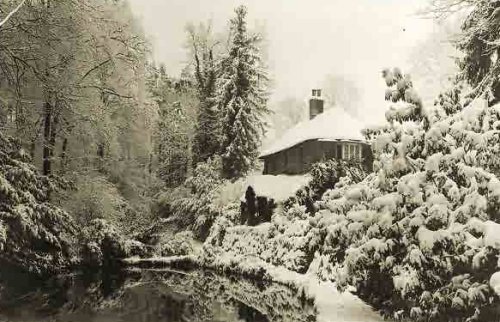
This
image
features in my
book 'Yeovil
- The Postcard
Collection'.
Ninesprings and the cottage photographed during the 'Great Snow' of 1909. This 'RP' postcard is by an unknown publisher, but was posted in 1909.
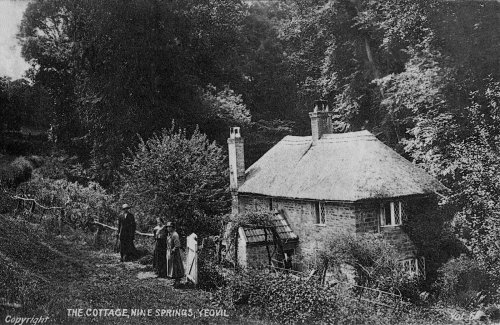
This postcard
features in my
book 'Yeovil
From Old
Photographs'
A printed postcard showing an unusual view of the cottage - the back. The postcard, published by Lilywhite Ltd of the Triangle, was posted in 1924.
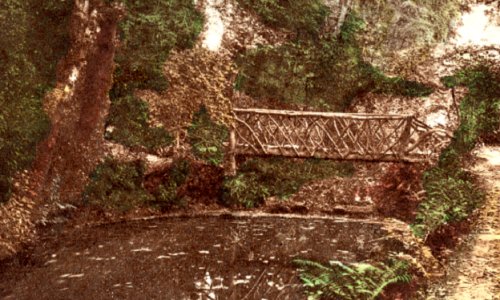
This
postcard
features in my
book 'Yeovil
- The Postcard
Collection'.
This hand-coloured printed postcard, dated 1936, shows the rustic bridge crossing the stream at the lower end of the Ninesprings valley. It was published by Photochrom in at least five versions.
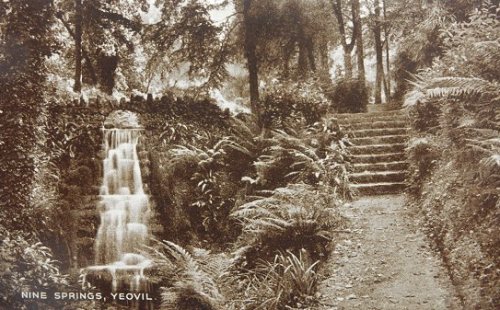
This postcard
features in my
book 'Yeovil
From Old
Photographs'
This 'RP' postcard by Valentine was posted in 1937. It gives a view of the cascade and steps.
![]()
General Views and Multiviews
Summerhouse Hill, to the immediate south of the town, is the obvious vantage point from which to take panoramic vistas of Yeovil. Over three dozen different postcards depicting views of the town from the summit of the hill were produced during the Edwardian era alone.
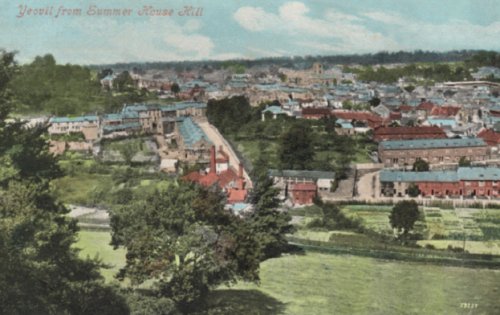
This hand-coloured printed postcard was published by Valentine and posted in 1904. It shows Mill Lane left of centre, with the large orchards of South Street House at centre. At centre right is Summerhouse Terrace (note the allotments) in front of Talbot Street. Within ten years, the orchards would be gone and Mill Lane would have houses on both sides.
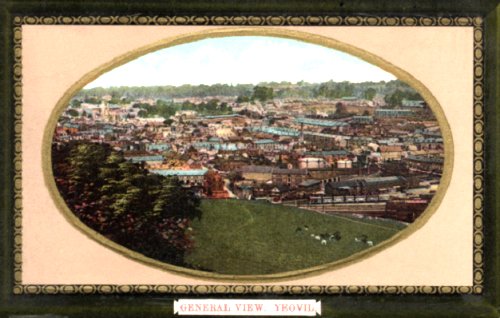
This printed postcard is one of a series of a dozen or so Yeovil postcards of Milton's "Sell Well" series using this Edwardian vignette and surround, dating to 1909. The view is slightly east of the previous postcard and features the Yeovil Town railway station at bottom right. Just visible above the station yard are the two gas-holders of the Town Gas Works. The actual image features in at least eight different postcards by Woolstone Brothers of London in several of their 'Milton' series.
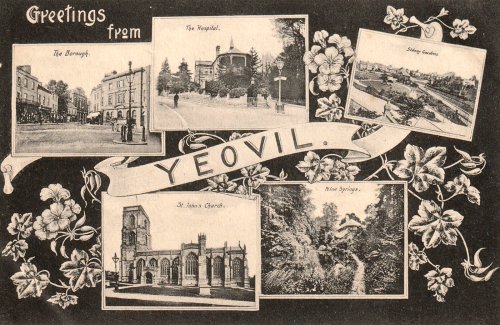
It was soon realised by the postcard publishers that you could offer more views for your money with a 'multiview' postcard – an early sales ‘gimmick’. This printed postcard is a very early example that was published by J Membury of Yeovil and posted in 1905.
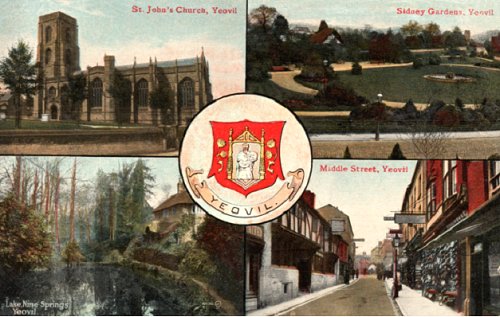
This printed multiview postcard, of 1918, is from a series of about a dozen postcards of the same period published by Yeovil stationer HT Balls. The series featured the town's crest at the centre of various views of the town. There were usually four views with a central crest in landscape orientation, as here, or two views and a crest in portrait format.
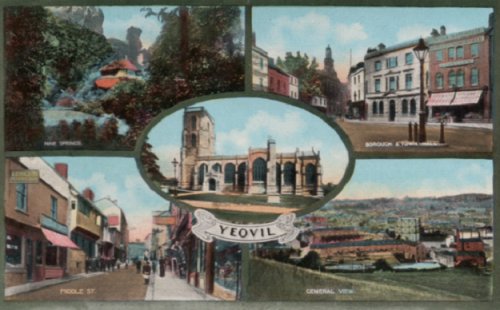
During the 1920s, a series of about a dozen multiview cards of Yeovil were produced, in both landscape and portrait formats, with five, six or seven views against a dark green background. Several were published by HT Balls of the Triangle, but the style was copied almost exactly by Jackson & Sons of Grimsby. This example was posted in 1922.
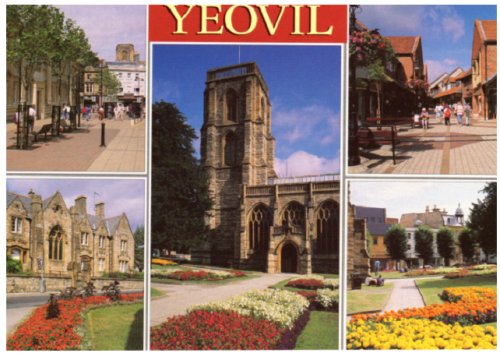
This multiview postcard is from Salmon of Sevenoaks, Kent, 'Cameracolour' series and dates to 1985. It features, at top left the newly-pedestrianised King George Street and at top right, the newly-opened Quedam shopping centre.
![]()
Novelties
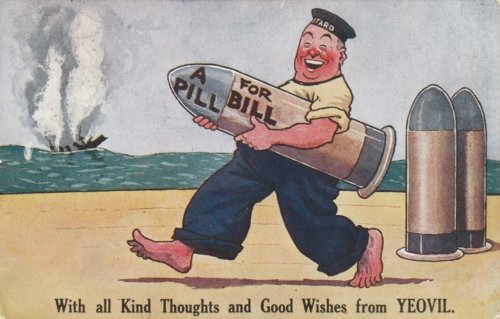
This is a very early 'novelty' card, clearly published during the Great War and showing what we had in store for Kaiser Bill. It was posted in 1915.
It was common practice to take a standard stock postcard, but individualise with the name of the town specifically for local sales - in this instance, and below, Yeovil.
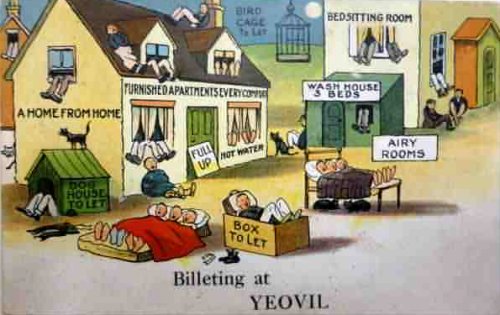
A humorous postcard of 1940, hinting at the lack of accommodation available in Yeovil for the influx of the 4,410 evacuees.
There were
several types of
novelty
postcards, but
perhaps the most
popular type
contained a
'hidden' strip
of small views,
invariably
monochrome, that
could be
revealed by
lifting a flap
on the front of
the card - as in
this novelty
card featuring a
kitten in a box.
These were
published by
Valentine during
the 1920s and
1930s and all
are personalised
for Yeovil.
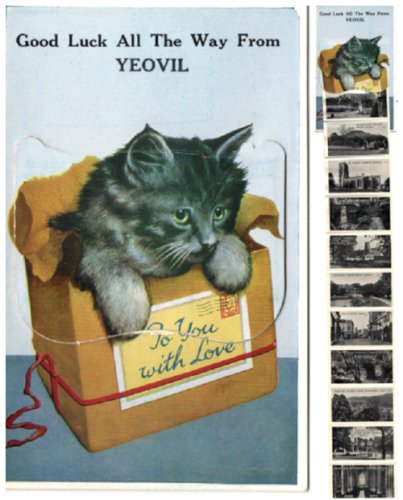
A novelty card - the flap is lifted to reveal eleven tiny folding views, seen at right.
Below are ten of Valentine's "Mailing Novelty" printed postcards from my collection (eight in portrait format and two in landscape format) including a plethora of lucky black kittens.
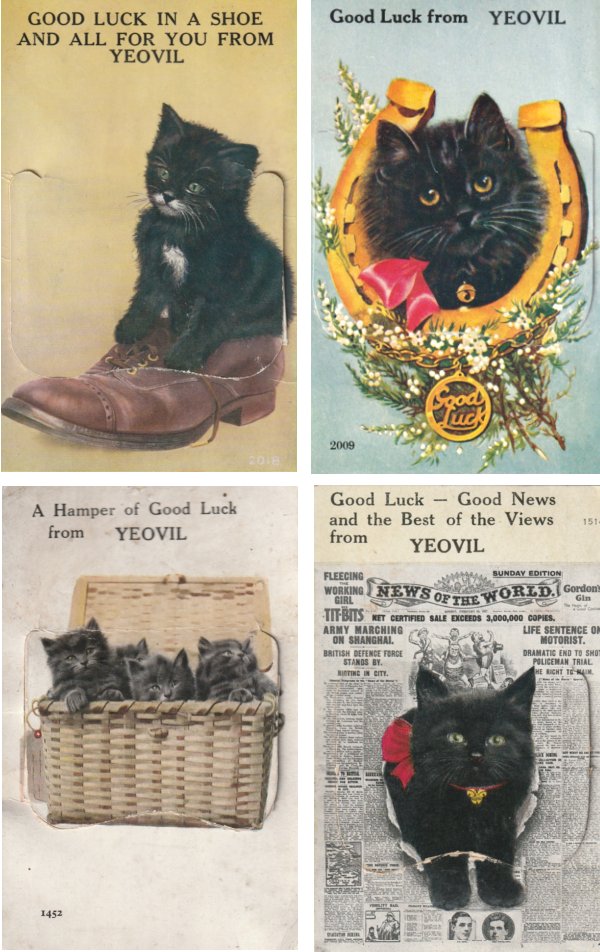
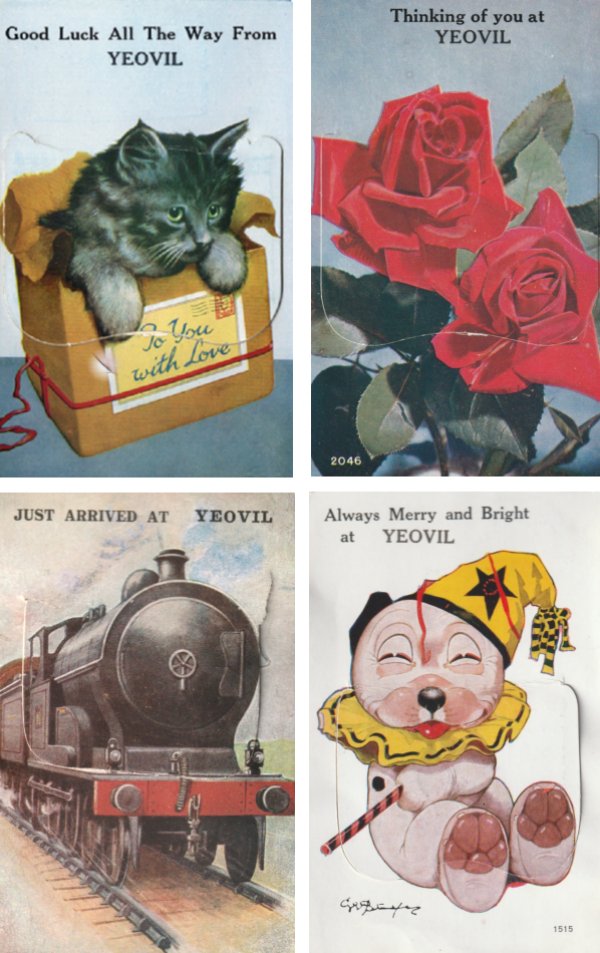
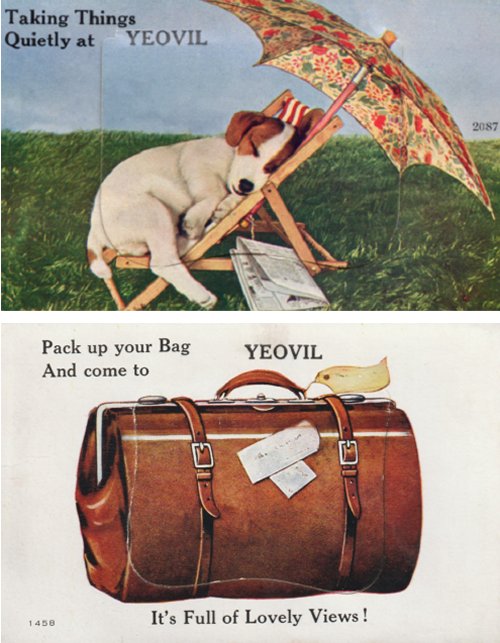
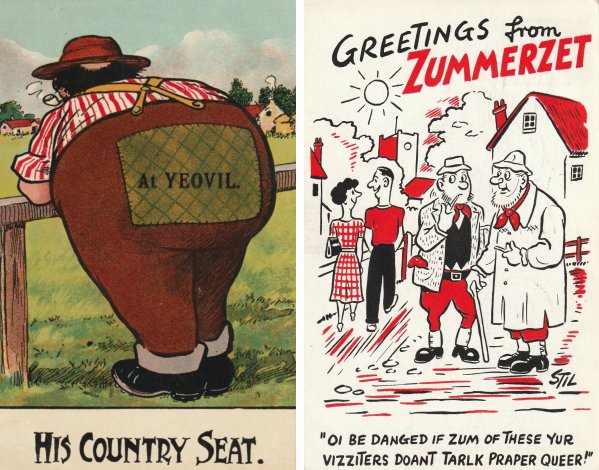
... and a couple more 'local' postcards - that at left from the 1940s and at left from the 1970s.
![]()
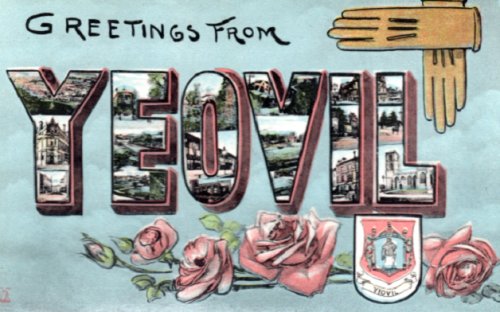
This postcard is from Milton's 'Glazette' series and is,
technically,
called a 'large
letter' type
because it
features the
name of the town
with each letter
containing small
views. In this
example, the
letters contain
a total of
nineteen views
as well as the
town crest and a
pair of leather
gloves
representing the
town's staple
trade at this
time. It was
posted in 1907.
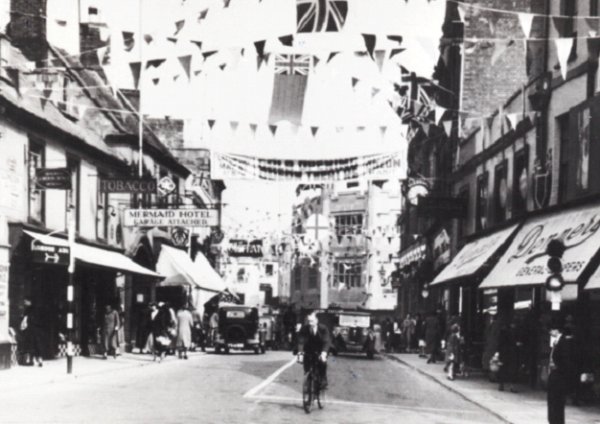
This card is a 'giant' postcard produced to celebrate the coronation of Elizabeth II in 1953. It was published by Vincent's of Yeovil as an advertising publicity device. Standard postcard measurements are 148 x 105 mm or 5.8 x 4.1 inches - but this card measures 214 x 150 mm or 8¼ x 6 inches.
![]()
Family Postcards
With the decline of the carte de visite and the cabinet card formats during the 1890s, local photographers moved towards producing their studio portraits as postcards - much cheaper for the client as well. This contributed greatly to the "Golden Age" of the postcard.
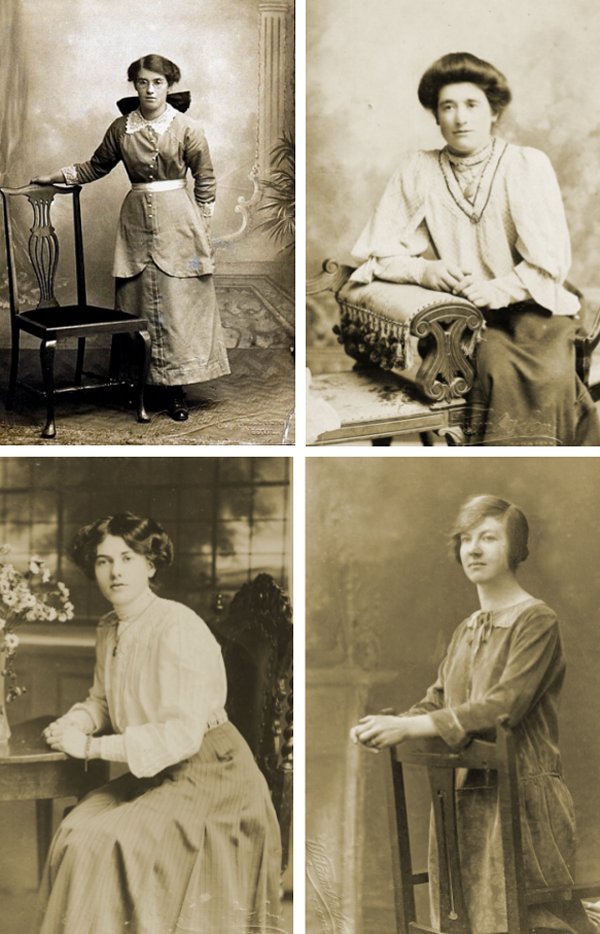
All four of the above photographs are studio portraits printed as postcards. At top left is a postcard of a lady by Walter Rendell taken in his Yeovil studio, probably around 1914. Those at top right and bottom left are both by Rendell, but later, say 1919, while bottom right is later still, say, mid-1920s,
![]()
The Great War, 1914-1918, saw tens of thousands of men go off to war. William Ross, for example, as a Yeovil photographer, had a tent studio set up on Salisbury Plain in order for soldiers to have their photographs taken, and printed as postcards to send back to loved ones before they set off for war.
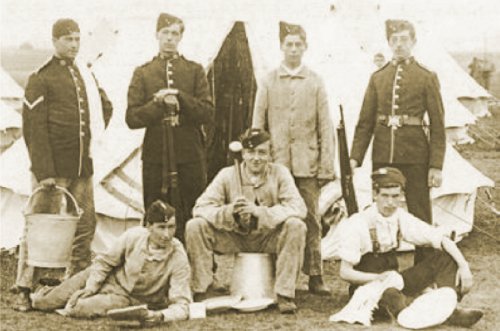
The postcard above, by an unknown photographer, shows recruits at a training camp where they would spend several weeks in training before being sent to the Front.
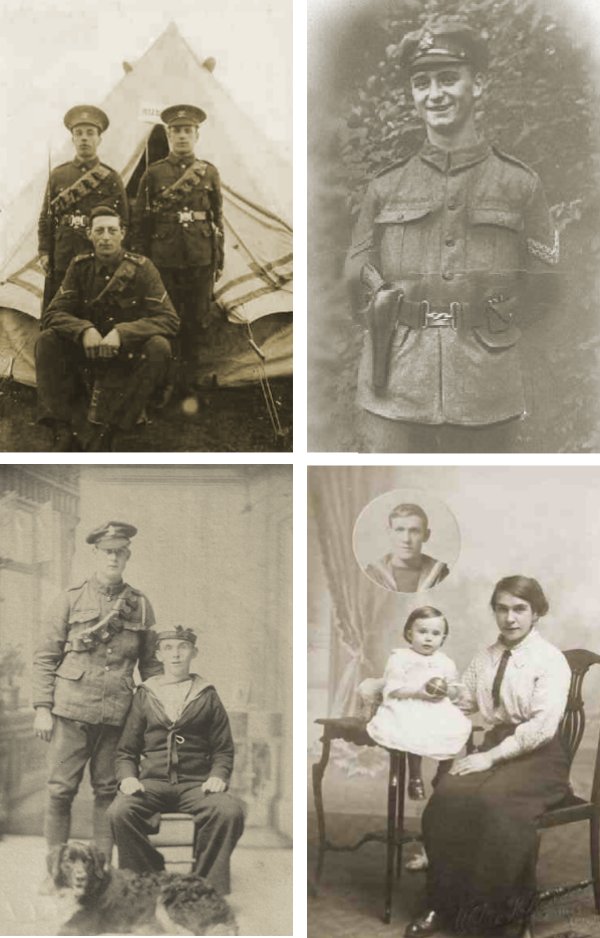
The four postcards above are all by local photographers, printed as postcards to be sent to friends and relatives as mementoes.
At top left is a postcard by William Ross and was taken on Salisbury Plain. The postcard of the Corporal at top right is by an unknown photographer. At bottom left is a studio portrait of two brothers (?) and the family dog, on leave or about to go to war, by Chaffin & Sons of Yeovil. At bottom right is a mother and child, with the father in a circular inset, by Walter Rendell. It is possible this last postcard is an 'in memoriam' postcard of the complete family after the husband was lost at sea.
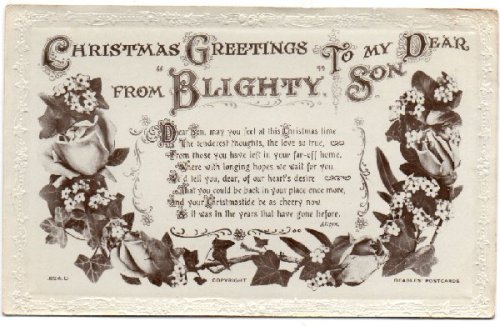
If you didn't have a photograph taken and produced as a postcard, you could always use a pre-printed one to send to your loved one serving abroad. This example is one of a series of eight Great War postcards sent to Sid Jackson of King Street from his mum and his sweetheart Dolly during 1915. Similar postcards were available at the Front, to be sent back home - as seen in this example below, sent home to his family in Yeovil by Wilfred Stanley Edwin Purchase.
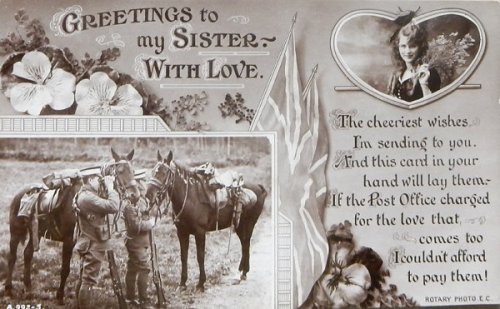
Courtesy of
Dinah Cheek
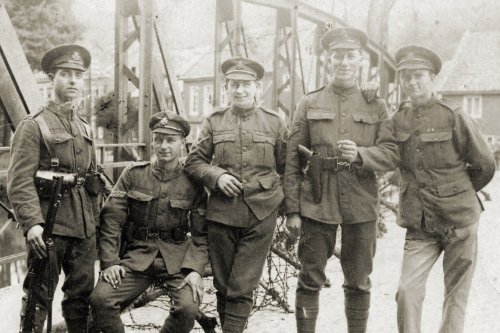
Of course, after the war, Britain left an occupation force in Germany. This photograph was taken in 1919 by a local German photographer and produced as a postcard for the soldiers to send home. It shows a group of British soldiers guarding a bridge over the Rhine. The seated Corporal is the same Corporal as at top right above.
